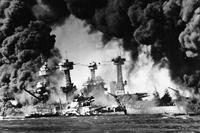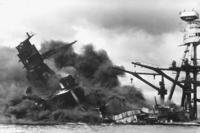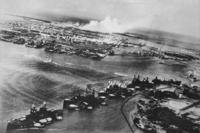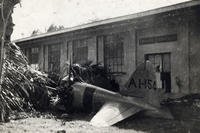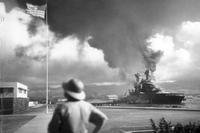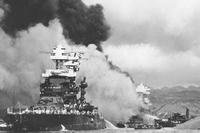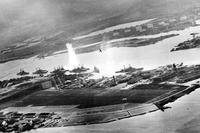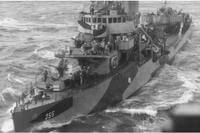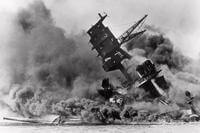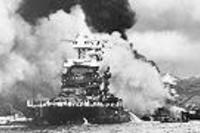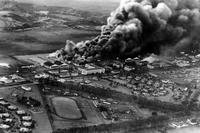Emboldened by a string of victories across the Pacific in the early months of World War II, the Japanese empire launched a bold and unorthodox attack that is seldom remembered today.
Though a tactical victory, the Dec. 7 attack on Pearl Harbor was also a strategic blunder, as the Japanese failed one of their most critical objectives: destroy the American aircraft carriers. Even worse, the Japanese failed to destroy the strategic oil reserves at Oahu, and the damage to docks and yards was slight.
According to "Pearl Harbor" by H.P. Willmott, the American fleet was damaged, but far from crippled.
The Japanese were desperate for information on the disposition of the U.S. fleet and its ability to project sea power, and not knowing was still a potential threat. It soon became apparent to the Imperial Japanese Navy (IJN) that a second attack was necessary.
The Second Pearl Harbor Attack
According to Steve Horn's book, The Second Attack on Pearl Harbor: Operation K And Other Attempts to Bomb America in World War II," the Japanese decided the attack would be carried out with long-range flying boats refueled by submarines.
The attack had three objectives: reconnoiter the damage of the original attack to the infrastructure at Oahu, disrupt salvage efforts and once again terrorize the population. The IJN reasoned that if successful, additional raids could occur.
After weeks of planning, the Japanese worked out the details. With no fighter escort available, they determined a nighttime raid would be their best option. They would launch Kawanishi H8K flying boats from the Wotje Atoll in the Marshall Islands. The H8k was considered one of the finest flying boats of the war, and their extreme range would allow them to fly the 1,900 miles to French Frigate Shoals in the northwestern Hawaiian Islands. Once there, they would rendezvous with submarines for refueling.
The planes would then fly off to Oahu to execute the attack. In an effort to disrupt salvage and repair efforts, their primary target was Pearl Harbor naval base's "Ten-Ten" dock -- so named for its length of 1,010 feet.
As a secondary mission, the aircraft were to make careful observations to obtain accurate intelligence of U.S. naval infrastructure. This would be crucial to helping IJN planners determine American capabilities.
To coincide with full moonlight over Pearl Harbor and have maximum visibility, the date planned for the raid was March 4, 1942.
The Second Attack's Failures
While audacious, the plan was plagued with errors. First, the number of aircraft available was cut to two. Second, a lookout submarine positioned south of French Frigate Shoals went missing in mid-February. Finally, Japanese cryptanalysts had broken the United States Navy weather code before the attack, but by the time of the raid, the code had changed. The moonlight that the raid depended on came from a single source, which later proved entirely inaccurate.
Blinded by foul weather, the pilots were forced to split up and carry out their attacks separately. The Japanese planes were picked up by radar, and the Americans scrambled their aircraft in an attempt to intercept what was presumed to be an airborne armada and the carrier task force that launched them. They were quickly thwarted by the same inclement weather blinding the Japanese.
Unable to see Oahu due to a wartime blackout, one pilot is presumed to have dropped his bombs harmlessly into the ocean while the other struck the slopes of Tantalus Peak, an extinct volcano cinder cone just north of Honolulu. Aside from a few blown-out windows, no damage occurred to any structures.
The early morning attack renewed fear among residents of a Japanese invasion and caused changes to U.S. naval strategy that would remain in place throughout the war.
In the days before the attack, American codebreakers warned that Japanese were preparing raids and would refuel at French Frigate Shoals. Shockingly, they were once again ignored by their superiors, much like the first attack on Dec. 7, 1941.
Despite the failure of the attack, its out-of-the-box thinking had major impacts on the war and demonstrated the potential of air power. American ships would patrol French Frigate Shoals for the remainder of the war, and greater attention was paid to the discoveries of codebreakers.
More importantly, American ships stationed at French Frigate Shoals denied the Japanese further use of the base to carry out reconnaissance missions. This left them unable to continue observing U.S. Navy activity or to keep track of the American carriers. These changes would prove pivotal, when only three months later, the two nations' fleets would converge at a small island chain called Midway.
Keep Up With the Best in Military Entertainment
Whether you're looking for news and entertainment, thinking of joining the military or keeping up with military life and benefits, Military.com has you covered. Sign up for a free Military.com membership to have military news, updates and resources delivered directly to your inbox.

